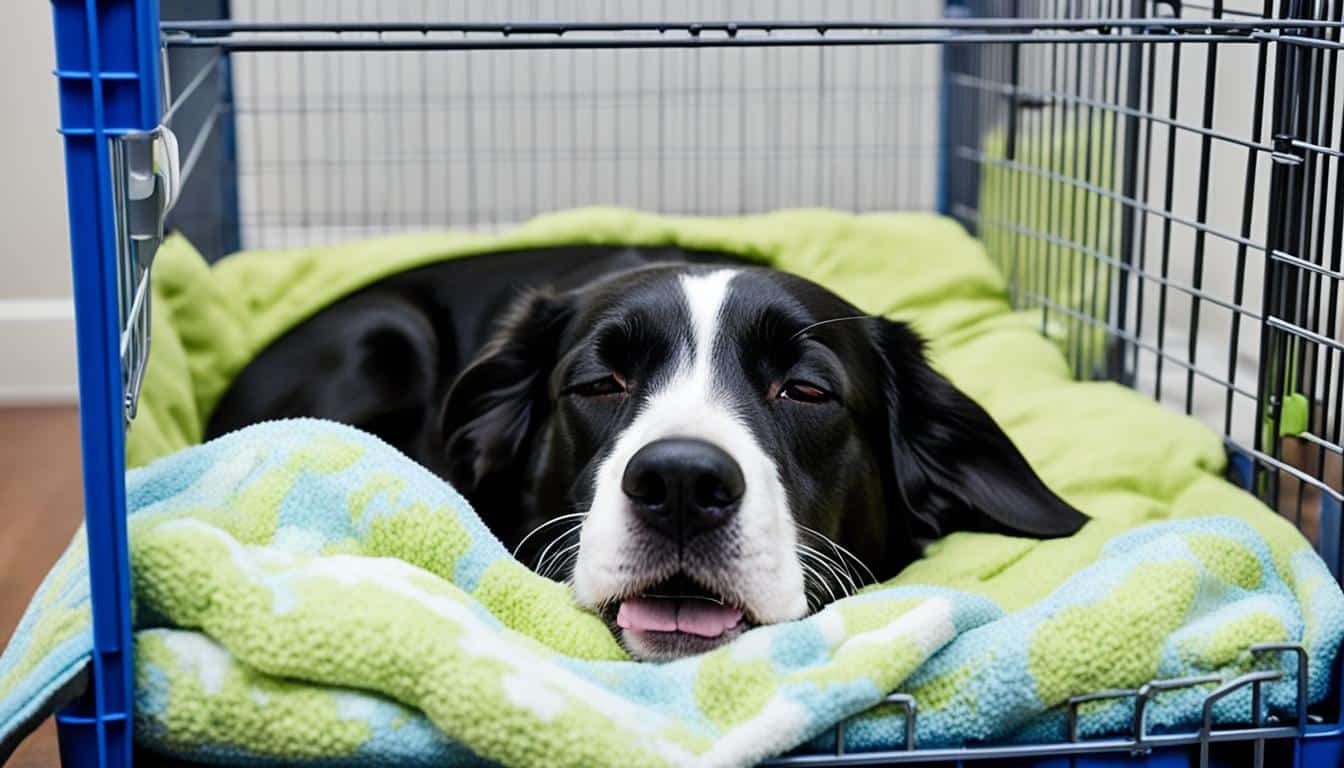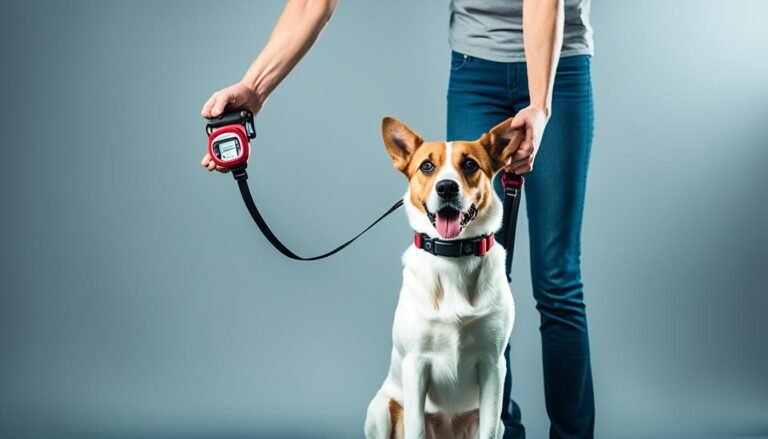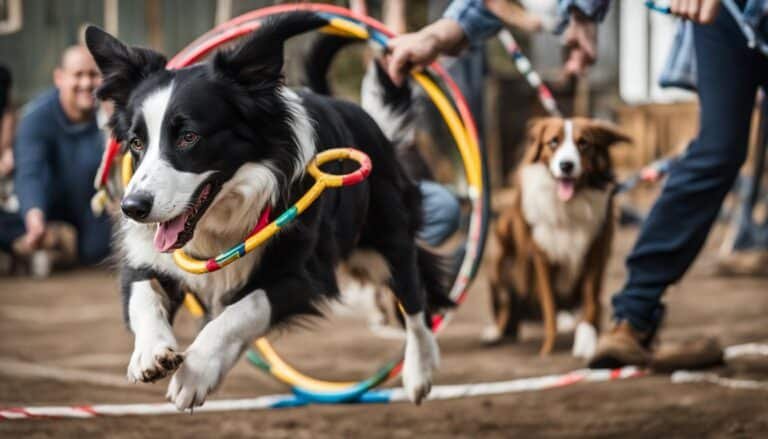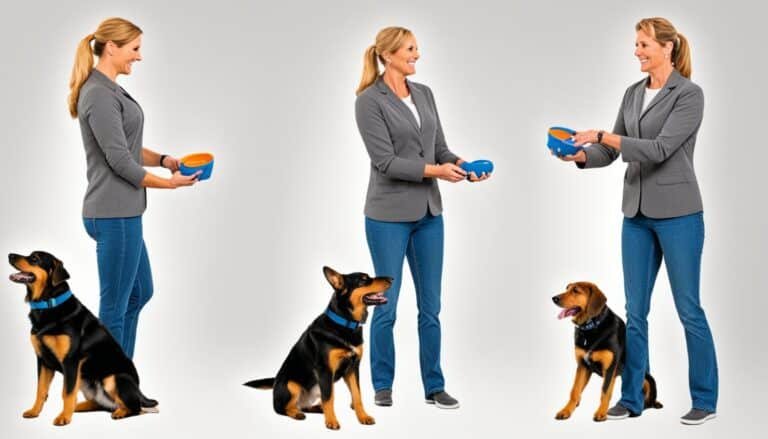How to Train a Dog to Sleep in a Crate
Imagine coming home after a long day, ready to relax and unwind. But as soon as you walk through the door, you find your favorite pair of slippers chewed up, pillows torn apart, and your dog wagging its tail, oblivious to the chaos it has created. Sound familiar?
If you’re tired of dealing with destructive behavior or accidents while you’re away, crate training could be the solution you’ve been looking for. Crate training provides a safe and comfortable space for your dog, giving them a sense of security and structure.
Whether you have a new puppy or an older dog, crate training can be a valuable tool in teaching your furry friend to sleep peacefully in a crate. In this article, we’ll explore the step-by-step process of crate training, from introducing the crate to establishing a nighttime routine. We’ll also provide you with tips and techniques to ensure a successful crate training experience.
By the end of this article, you’ll have all the knowledge and confidence you need to train your dog to sleep soundly in a crate. So let’s dive in and discover the secrets to successful crate training!
Crating Caution and Crate Selection
While crate training can be an effective tool for behavior management, it’s crucial to approach it with caution and make responsible choices in crate selection. Crate training should never involve punishment, and it’s important to be mindful of the amount of time your dog spends in the crate.
When choosing a crate, there are different types to consider, each with its own benefits. Plastic crates provide a secure and enclosed space for your dog, while fabric crates offer portability and convenience. Metal pens are versatile and can be configured according to your needs. Adjustable crates that grow with your dog’s size are ideal for puppies.
Regardless of the type you choose, ensure that the crate is spacious enough for your dog to stand up, turn around, and stretch comfortably. Providing a proper crate size is essential for your dog’s well-being.
For added flexibility, renting a crate until your puppy reaches their adult size can be a cost-effective option.
- Choose a crate type suitable for your dog’s needs and your lifestyle.
- Ensure the crate is spacious enough for your dog’s comfort.
- Remember to never use the crate for punishment.
- Use the crate as a positive space for your dog’s behavior management.
- Monitor the time your dog spends in the crate, avoiding excessive confinement.
By approaching crate training with caution and making the right selections, you can create a safe and comfortable space for your dog while effectively managing their behavior.
The Training Process
Crate training is a journey that requires patience and consistency. By following the right steps, you can help your dog develop a positive association with their crate and make it a comfortable and safe space for them.
Step 1: Introducing the Crate
Start by introducing the crate to your dog in a positive way. Place the crate in a quiet area of your home and leave the door open. Allow your dog to explore the crate at their own pace, sniffing and investigating it without any pressure. You can also make the crate more inviting by placing treats or toys inside to encourage your dog to enter.
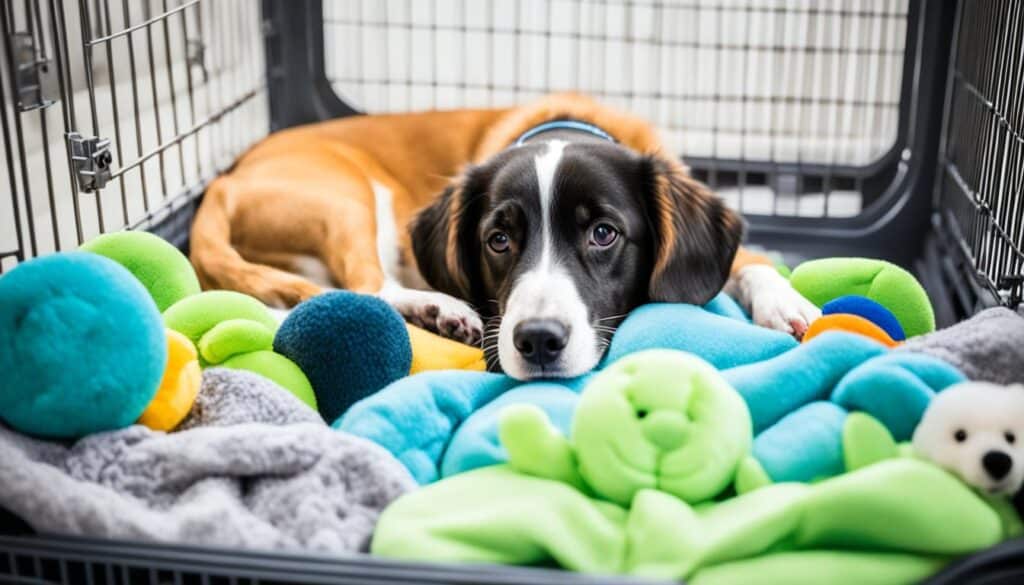
Step 2: Feeding Meals in the Crate
One way to create a positive association with the crate is by feeding your dog their meals near the crate. Gradually move the food bowl closer to the crate, and eventually place it inside the crate. This will help your dog associate the crate with something pleasant and rewarding.
Step 3: Practicing Longer Crating Periods
Once your dog is comfortable entering the crate and eating their meals inside, you can start practicing longer crating periods while you’re at home. Encourage your dog to enter the crate and close the door for short periods of time. Stay nearby and provide reassurance and praise. Gradually increase the duration of these crating periods to help your dog build confidence and comfort.
Step 4: Crate Training During the Day and at Night
Extend the crate training to different times of the day. Encourage your dog to enter the crate and close the door while you go about your daily routine. This will help them adjust to being crated when you leave the house. Similarly, crate your dog at night for sleep. Ensure the crate is comfortable with bedding and toys to create a cozy environment.
Remember, crate training is a process, and each dog will progress at their own pace. By following these steps and being consistent in your approach, you can help your dog develop a positive relationship with their crate and create a peaceful and secure space for them.
Crate Training Tips
When it comes to crate training your dog, there are several tips and techniques you can use to ensure a successful and positive experience. From establishing the right mindset to creating a comfortable crate space, here are some helpful tips to assist you in crate training your furry friend:
1. Establishing the Right Mindset
One of the key factors in crate training is establishing the right mindset for your dog. Help your dog associate the crate with relaxation by introducing it gradually and using positive reinforcement. Start by leaving the crate door open and placing treats or toys inside to entice your dog. Encourage your dog to enter the crate willingly and reward them with treats and praise when they do so. By establishing a positive association, your dog will be more inclined to view the crate as a safe and comfortable space.
2. Creating a Comfortable Crate
It’s essential to create a comfortable and inviting space inside the crate for your dog. Experiment with different bedding options such as cozy blankets or a comfortable dog bed to find what works best for your pet. Ensure that the crate is appropriately sized, allowing your dog to stand, turn around, and lie down comfortably. Adding familiar scents, such as a piece of your clothing, can help provide a sense of security for your dog.
3. Rewarding Your Dog
Using rewards is an effective way to reinforce positive behaviors during crate training. Whenever your dog enters the crate willingly or exhibits calm behavior inside the crate, reward them with treats and verbal praise. This positive reinforcement helps your dog associate the crate with positive experiences and encourages them to view it as a desirable place to be.
4. Incorporating Crate Games
To make crate training more enjoyable for your dog, incorporate crate games into the training routine. These games can help alleviate boredom and anxiety associated with being confined in the crate. Hide treats or toys inside the crate and encourage your dog to find them. This engages their mind and keeps them occupied while reinforcing their comfort and positive association with the crate.
5. Keeping the Crate “Naked”
When your dog is inside the crate, it’s important to remove collars and tags to prevent any accidents or potential entanglements. Keeping the crate “naked” eliminates the risk of your dog getting caught on anything and ensures their safety while inside the crate.
By following these crate training tips, you can establish a positive and rewarding experience for both you and your dog. With patience, consistency, and the right mindset, your dog will soon view their crate as a safe and comfortable space they can call their own.
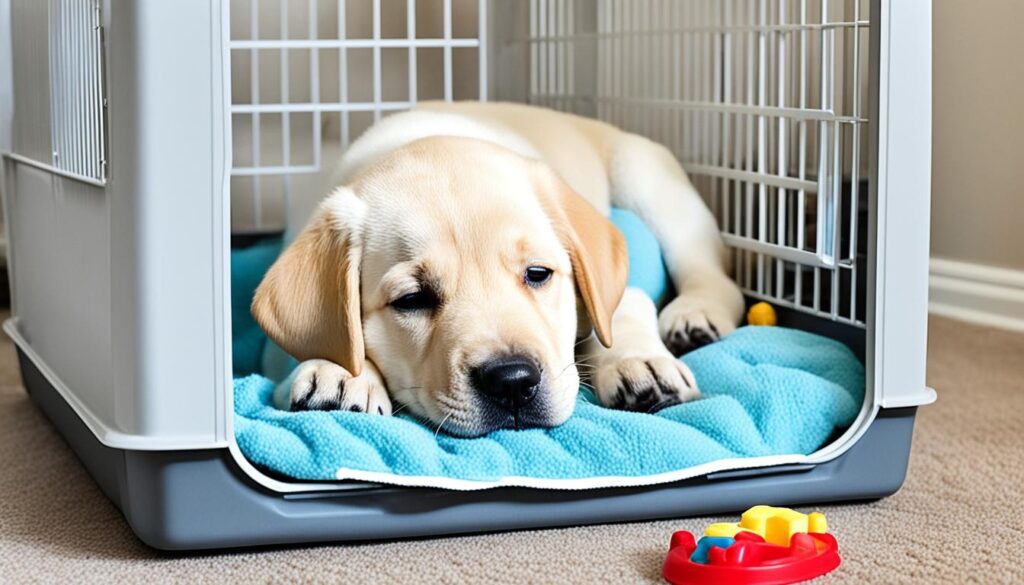
Setting Up a Puppy’s Crate for Nighttime Rest
When it comes to setting up your puppy’s crate for a restful night of sleep, there are a few key factors to consider. The location of the crate, its comfort, visibility, and the use of a snuggle puppy can all contribute to a positive sleeping environment.
Choosing the Right Location
The location of your puppy’s crate can greatly impact their comfort and sense of security. Consider placing the crate in your bedroom if you want to be close to your puppy during the night. This can help them feel safe and reduce any anxiety they may have about being alone. If you prefer to keep the crate in a different room, choose a quiet corner where your puppy won’t be disturbed.
Create a Comfortable Space
Make sure your puppy’s crate is a cozy and inviting place for them to rest. Use soft bedding that is appropriate for their size and breed. This can include blankets, towels, or a dog bed specifically designed for crates. Adding a familiar-smelling item, such as a t-shirt you’ve worn, can also provide comfort and reassurance.
Ensure Adequate Visibility
Having visibility in the crate can help your puppy feel less confined and more connected to their surroundings. Choose a crate with adequate ventilation, such as one with metal or wire construction. This allows for proper airflow and visibility, creating a more open and comfortable space for your puppy.
The Snuggle Puppy Solution
Some puppies may benefit from the company of a snuggle puppy in their crate. A snuggle puppy is a soft plush toy with a heat pack and a simulated heartbeat. This can provide additional comfort and mimic the warmth and presence of littermates, helping to ease any separation anxiety your puppy may feel. Introducing a snuggle puppy can make the crate feel like a safe and reassuring place for your furry friend.
By setting up your puppy’s crate in the right location, ensuring comfort and visibility, and even using a snuggle puppy, you can create a peaceful and inviting sleeping space for your furry friend.
Dealing with Whining and Barking
During the process of crate training, you may encounter instances of puppy whining and barking. Understanding the reasons behind these behaviors is crucial in addressing them effectively. Whining and barking can be signs of distress or demand, and it’s important to respond appropriately to promote a calm and peaceful crate experience.
Distress Barking: If your puppy exhibits whining or barking that appears to stem from stress or anxiety, it’s important to provide them with comfort and support. Reassure your puppy with a calm tone of voice and gentle physical contact if they are receptive to it. Offering a comforting item, such as a soft blanket or a snuggle toy, can also help alleviate their distress. Gradually, as your puppy becomes more comfortable with crate training, their distress barking should decrease.
Demand Barking: Demand barking occurs when a puppy barks to get your attention or to obtain something they want. This behavior can inadvertently be reinforced if you respond to their barking by giving in to their demands. Instead, it’s essential to ignore the barking and only acknowledge and reward your puppy when they are calm and quiet. By establishing consistent boundaries and reinforcing calm behavior, demand barking can be minimized.
It’s important to establish a consistent nighttime routine to foster good behavior and promote a peaceful sleep environment for your puppy. This routine should include activities such as a pre-bedtime potty break, providing a calm and comfortable crate environment, and ensuring your puppy has had sufficient exercise and mental stimulation before bedtime. Additionally, avoid responding to whining and barking by letting your puppy out of the crate, as this can reinforce the behavior.
Nighttime Potty Breaks
Puppies are prone to accidents during the night, which is why establishing a routine for nighttime potty breaks is crucial. By taking proactive steps, you can prevent accidents and aid in your puppy’s crate training journey.
Preventing Accidents
To avoid accidents in your puppy’s crate, it’s important to take them outside for a bathroom break before bedtime. This will give them a chance to relieve themselves and empty their bladder.
Timing for Potty Breaks
Set an alarm to wake up before your puppy does for additional nighttime potty breaks. By doing this, you’ll proactively address their needs and prevent accidents in the crate.
Managing Water Intake
Be mindful of your puppy’s water intake, especially in the evening. Limit their access to water a few hours before bedtime to reduce the likelihood of needing frequent potty breaks during the night.
Gradually extend the time between bathroom breaks as your puppy learns to hold their bladder for longer periods. With consistent training and patience, accidents will become less frequent, and your puppy will become more adept at controlling their bladder.
Patience and Persistence
Crate training is a process that requires patience and persistence. Remember, your puppy is constantly learning, and setbacks may occur along the way. But with consistent training and a calm approach, you can achieve crate training success.
Be patient with your puppy’s learning process. Understand that it takes time for them to adjust to the crate and learn the desired behaviors. Give them the opportunity to explore and familiarize themselves with the crate at their own pace.
Stay persistent in your training approach. Consistency is key when it comes to crate training. Stick to a routine and reinforce positive behaviors consistently. Your dog will eventually associate the crate with comfort and security, and look forward to being in it.
Remember, crate training is a journey that requires your dedication. Stay positive and celebrate small wins along the way. With patience and persistence, you will help your puppy develop good crate habits and create a peaceful and safe sleeping environment for them.
